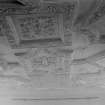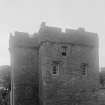Field Visit
Date 21 August 1913
Event ID 1089160
Category Recording
Type Field Visit
Permalink http://canmore.org.uk/event/1089160
213. Whittinghame Castle.
Whittinghame Castle, a late 15th or early 16th century tower (fig. 18 [SC 1128544]), stands about ¼ of a mile south-south-west of the modern mansion of Whittinghame on the opposite bank of the wooded ravine through which flows the Whittinghame Water. The building stands some 33 yards back from the edge of this ravine, which forms a natural defence and boundary on the east. On plan the structure is L-shaped (fig. 172); the main block contains the apartments and measures externally 30 ½ feet by 24 feet, while the wing 13 feet by 14 feet, projects, not from a lateral wall as is usual, but from the north gable and contains the entrance and the staircase, which is rectangular on the lower flights and circular above. There are three storeys beneath the wall head, which terminates in a corbel course surmounted by a walk with a crenellated parapet, which returns round the whole building. A garret over the main block is entered from the parapet walk.
The entrance (fig. 44 [SC 1128542]) to the building is in the north wall of the staircase wing and not in there-entering angle. On the jambs and lintel of the doorway is wrought a bold quirked bead and-hollow moulding; on the lintel is a shield charged as under-parted per pale, dexter a cinque foil beneath two stars on a chief; sinister a boar's head erased beneath two stars in chief (for Douglas): the cinquefoil shows maternal descent from Borthwick. The Douglases of Whittinghame being descended from the Earl of Morton used their arms with a difference.
The basement chamber has been modernised but retains its stone vaulted ceiling, below which a mezzanine floor was entered off the staircase but has been removed. The windows have been enlarged, and direct access with the exterior provided in the east wall. The principal apartment of the tower is situated immediately over the vault and is entered from the staircase, which at this height has attained a circular form. The apartment measures 21 ½ feet by 15 feet; in the east and west walls are deeply recessed windows and in the south gable a fireplace. The northern end was screened off at the small window in the west wall, forming the servery usual in buildings of this type. Mural closets are formed in the thickness of the walls at the north-east angle and a cupboard in the north wall. The panelled ceiling (fig. 173 [SC 1128541]) is well preserved and is a good example of 17th century plaster work; the architraves of the doors are coeval and are carved with an egg-and-dart enrichment reminiscent, although the motif is different, of the woodwork at Pilmuir House (No. 20) in the parish of Bolton. Although this apartment has been enlarged by the inclusion of the servery and otherwise slightly modernised, it still retains much of it sold time appearance.
The floor above is occupied by estate employees.
Adjoining the tower on the east are the remains of 17th century outbuildings with vaulted ceilings, and farther east a raised garden terrace is reached from stairs on the north and south. The tower is in excellent condition.
HISTORICAL NOTE.
Whittinghame was part of the great historical possessions of the Earls of March, till in 1372 George of Dunbar, 10th Earl of March, conferred the lands on Sir James Douglas of Dalkeith (1) who had married his sister Agnes and was the founder of the Collegiate Church of Dalkeith. His son became first Lord Dalkeith and his grandson, on marrying a daughter of James I, first Earl of Morton. The fourth Earl was the Regent Morton (1572-8) and it was at Whittinghame that the proposal for the assassination of Darnley was made to him by Bothwell and Lethington in January 1567. On his execution and forfeiture in 1581, title and lands lapsed to the Crown, but were later returned to the representative of the family. Whittinghame passed in 1660 to Alexander Seton first Lord Kingston (cf. p. 67), who had married Elizabeth, daughter of Sir Archibald Douglas of Whittinghame and heiress of her brother Archibald, and again by marriage with Kingston's only surviving daughter to the Hon. William Hay of Drummelzier, son of the first Earl of Tweeddale, remaining with the Hays till it was sold in 1817, along with Stoneypath to Mr. James Balfour.
RCAHMS 1924, visited 21 August 1913.
(1) Reg. Mag. Sig. i., No. 522; (2) Family of Seton, ii., pp. 717, 721; New Stat. Acct. ii., p.64.
OS Map ref: xi. N.W.











